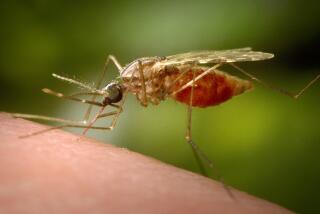Smelly socks could help curb malaria
- Share via
Reporting from Johannesburg, South Africa — As a boy in remote western Kenya, Fredros Okumu sat under the stars, smothered by the smoke of the family fire, until it was time to go to bed.
Even now, when he returns home to his village, a 29-year-old man who left and achieved things, he still sits in the darkness, eyes stinging, nose running, enveloped in the choking smoke. Its smell clings to his hair and clothing, but at least it serves its purpose: keeping the mosquitoes at bay.
Like almost everyone in the village of Uyoma, Okumu lost family and friends to mosquito-borne malaria when he was growing up. So the smoke of burning Kenyan bush herbs was his friend.
“One of the things growing up, I caught malaria at least twice a year. I lost cousins, around five of them. And if you speak to any African boy who is 29 years old and grew up in an African village, he would either have a similar situation, or worse,” he said in a phone interview from Tanzania, where he works as an entomologist for the Ifakara Health Institute, a medical and public health research institute.
Mosquitoes responsible for spreading malaria, such as the female Anopheles varieties, are particularly attracted to feet.
In a splendid example of African inventiveness, Okumu is developing a toxic mosquito trap for African villages that attracts the insects using a human scent that mosquitoes apparently cannot resist: smelly socks.
After his mentor, a Dutch medical entomologist, discovered the insects’ strange affinity to foot odor by standing naked in a room full of mosquitoes to see where they bit him, Okumu was driven to find a cheap, practical way to use the knowledge. His plan would enlist the services of villagers who would wear cotton pads in their socks, to be used as bait in mosquito traps, a cheaper option for villages than using chemically synthesized foot odor.
The project, which has received $775,000 in funding from the Bill & Melinda Gates Foundation and Grand Challenges Canada, is designed to eradicate mosquitoes outdoors, to complement the big strides made in cutting malaria deaths using treated bed nets, malarial drugs and spraying.
“We believe African innovators are best placed to solve African problems,” said Peter Singer of Grand Challenges Canada, which seeks out African inventors with out-of-the box ideas. “I think there’s a lot of value at the table in terms of tapping bright young African innovators who have great ideas and who could be more fully enabled to tackle their own challenges.”
Some African countries have seen dramatic reductions in malaria rates by employing a raft of control techniques. Malaria deaths were cut by about 50% in nine African countries between 2006 and 2008, according to the World Health Organization, including Tanzania, Zambia, Ethiopia, Rwanda and Ghana. But there were still 243 million cases of malaria worldwide in 2008 and 863,000 deaths, mostly among children — with Africa accounting for 90% of malaria deaths.
Although the poor are the most vulnerable, no one is spared. One of Okumu’s colleagues at the Ifakara institute recently lost a child to malaria.
Okumu was drawn into mosquito research almost by accident, when he volunteered to be a subject in a mosquito project after leaving his village to go to high school.
After high school he got a job with a mosquito research team run by Bart G.J. Knols, a Dutchman who was looking at the efficacy of traditional Kenyan mosquito repellents.
After six months on the job, Okumu became obsessed. When other members of the team were resting in the evenings or writing up research reports, he was creeping around the compound, spraying the mosquitoes, determined to get rid of the pests.
“I figured out that I could do something practical. I’d go around the compound spraying mosquito breeding sites, just to kill mosquitoes. This was not a scientific part of the project. It was my original scientific passion developing into a need to do something practical. Since that time, I have always wanted to work on mosquitoes.”
It was Knols who discovered that mosquitoes were most attracted to smelly feet. But Okumu decided to apply the discovery to an outdoor mosquito trap.
Okumu’s plan to use actual smelly socks odor offers a cheap alternative to a chemical smell and can be easily replaced by villagers. He plans to focus on youths playing soccer, or laborers, as a source for the sock pads.
“We hope this will reduce the cost but also create a level of interest in the community,” he said.
The mosquito trap is a wooden box with louver vents and a battery-run fan to blow the sock odor into the air through a bamboo pipe. The next phase of his research is to figure out the best places in the village to post mosquito traps, develop a trap that will cost only a few dollars, and to determine how an outdoor mosquito-control routine involving smelly socks can be a regular part of village life.
Having grown up in a village, he knows what might work, and what won’t.
“I still visit my village a lot and I see how things are being done,” he said. “I still sit around my mother’s fire and my nose still runs the way it did 20 years ago and my eyes still sting. Life is not very different.”
More to Read
Sign up for Essential California
The most important California stories and recommendations in your inbox every morning.
You may occasionally receive promotional content from the Los Angeles Times.










